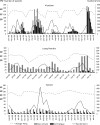Molecular epidemiology of dengue viruses in three provinces of Lao PDR, 2006-2010
- PMID: 29377886
- PMCID: PMC5805359
- DOI: 10.1371/journal.pntd.0006203
Molecular epidemiology of dengue viruses in three provinces of Lao PDR, 2006-2010
Abstract
Few data on dengue epidemiology are available for Lao PDR. Here, we provide information on the complexity of dengue epidemiology in the country, demonstrating dynamic circulation that varies over space and time, according to serotype. We recruited 1,912 consenting patients presenting with WHO dengue criteria at Mahosot Hospital, Vientiane (central Laos), between 2006 and 2010. Between 2008 and 2010, 1,413 patients with undifferentiated fever were also recruited at Luang Namtha (LNT) Provincial Hospital (northern Laos) and 555 at Salavan (SV) Provincial Hospital (southern Laos). We report significant variations in Dengue virus (DENV) circulation between the three sites. Peaks of DENV infection were observed in the rainy seasons, although 11% of confirmed cases in the provinces and 4.6% in the capital were detected during the dry and cool seasons (between December and February). Four DENV serotypes were detected among the 867 RT-PCR positive patients: 76.9% DENV-1, 9.6% DENV-2, 7.7% DENV-4 and 5.3% DENV-3. DENV-1 was the predominant serotype throughout the study except in LNT in 2008 and 2009 when it was DENV-2. Before July 2009, DENV-2 was not detected in SV and only rarely detected in Vientiane. DENV-3 and DENV-4 were commonly detected in Vientiane, before 2008 for DENV-4 and after 2009 for DENV-3. The phylogenetic analyses of DENV envelope sequences suggest concurrent multiple introductions of new strains as well as active DENV circulation throughout Laos and with neighboring countries. It is therefore of great importance to develop and strengthen a year-round nation-wide surveillance network in order to collect data that would allow anticipation of public health issues caused by the occurrence of large dengue outbreaks.
Conflict of interest statement
The authors have declared that no competing interests exist.
Figures





References
-
- WHO; Dengue Haemorrhagic fever: diagnosis, treatment, prevention and control, 2nd edition. WHO; 1997.
-
- WHO. Dengue: guidelines for diagnosis, treatment, prevention and control—New edition WHO; 2009. - PubMed
-
- Dejnirattisai W, Jumnainsong A, Onsirisakul N, Fitton P, Vasanawathana S, Limpitikul W, et al. Cross-reacting antibodies enhance dengue virus infection in humans. Science. 2010;328: 745–748. doi: 10.1126/science.1185181 - DOI - PMC - PubMed
-
- Fox A, Le NMH, Simmons CP, Wolbers M, Wertheim HFL, Pham TK, et al. Immunological and viral determinants of dengue severity in hospitalized adults in Ha Noi, Viet Nam. PLoS Negl Trop Dis. 2011;5: e967 doi: 10.1371/journal.pntd.0000967 - DOI - PMC - PubMed
-
- Vu TTH, Holmes EC, Duong V, Nguyen TQ, Tran TH, Quail M, et al. Emergence of the Asian 1 genotype of dengue virus serotype 2 in viet nam: in vivo fitness advantage and lineage replacement in South-East Asia. PLoS Negl Trop Dis. 2010;4: e757 doi: 10.1371/journal.pntd.0000757 - DOI - PMC - PubMed
Publication types
MeSH terms
Grants and funding
LinkOut - more resources
Full Text Sources
Other Literature Sources
Medical
Molecular Biology Databases

